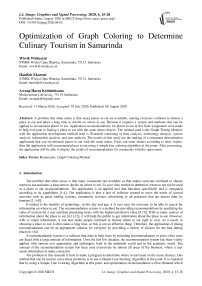Optimization of Graph Coloring to Determine Culinary Tourism in Samarinda
Автор: Wiwik Widiyatni, Hanifah Ekawati, Awang Harsa Kridalaksana
Журнал: International Journal of Image, Graphics and Signal Processing @ijigsp
Статья в выпуске: 4 vol.12, 2020 года.
Бесплатный доступ
A problem that often arises is that many places to eat are available, making everyone confused to choose a place to eat and takes a long time to decide on where to eat. Because it requires a system and methods that can be applied to recommend places to eat. Application recommendations for places to eat in this final assignment were made to help everyone in finding a place to eat with the same menu choices. The method used is the Graph Tinting Method, with the application development method used is Waterfall consisting of data analysis, technology analysis, system analysis, information analysis, and user analysis. The results of this study are the making of a restaurant determination application that can recommend places to eat with the same menu. Users can enter menus according to their wishes, then the application will recommend places to eat using a simple line coloring algorithm at the point. After processing, the application will be able to display the results of recommendations for restaurants with the same menu.
Restaurants, Graph Coloring Method
Короткий адрес: https://sciup.org/15017360
IDR: 15017360 | DOI: 10.5815/ijigsp.2020.04.02
Список литературы Optimization of Graph Coloring to Determine Culinary Tourism in Samarinda
- Davis, W. S., & Yen, D. C. (Eds.). (2019). The information system consultant's handbook: Systems analysis and design. CRC press.
- Zulaika, U., Gutiérrez, A., & López-de-Ipiña, D. (2018). Enhancing profile and context aware relevant food search through knowledge graphs. In Multidisciplinary Digital Publishing Institute Proceedings (Vol. 2, No. 19, p. 1228).
- Gardner, S., Nesi, H., & Biber, D. (2019). Discipline, level, genre: Integrating situational perspectives in a new MD analysis of university student writing. Applied Linguistics, 40(4), 646-674.
- Xu, X., & Huang, Y. (2019). Restaurant information cues, Diners’ expectations, and need for cognition: Experimental studies of online-to-offline mobile food ordering. Journal of Retailing and Consumer Services, 51, 231-241.
- Urbinati, A., Bogers, M., Chiesa, V., & Frattini, F. (2019). Creating and capturing value from Big Data: A multiple-case study analysis of provider companies. Technovation, 84, 21-36.
- McQuade, J. M., Murray, R. M., Louie, G., Medin, M., Pahlka, J., & Stephens, T. (2019). Software is never done: Refactoring the acquisition code for competitive advantage. Washington DC: Defense Innovation Board. Accessed August, 19, 2019.
- Khalid, L. (2020). Achieving Quality Attribute. In Software Architecture for Business (pp. 51-75). Springer, Cham.
- Leskovec, J., Rajaraman, A., & Ullman, J. D. (2020). Mining of massive data sets. Cambridge university press.
- Cui, H., Rajagopalan, S., & Ward, A. R. (2020). Predicting product return volume using machine learning methods. European Journal of Operational Research, 281(3), 612-627.
- Lantz, B. (2019). Machine Learning with R: Expert techniques for predictive modeling. Packt Publishing Ltd.
- Xu, F., Zhen, F., Qin, X., Wang, X., & Wang, F. (2019). From central place to central flow theory: an exploration of urban catering. Tourism Geographies, 21(1), 121-142.
- Kurniawan, R., Sutawan, A., & Amalia, R. (2020). Information System Ordering Online Restaurant Menu At Hover Cafe. Aptisi Transactions on Management (ATM), 4(1), 32-40.
- Calinger, R. S. (2019). Leonhard Euler: Mathematical Genius in the Enlightenment. Princeton University Press.
- Jarzabek, S., Poniszewska-Marańda, A., & Madeyski, L. (Eds.). (2020). Integrating Research and Practice in Software Engineering. Springer.
- Pickett, D. (2018). Financial Waterfall Model Development. American Bankruptcy Institute Journal, 37(4), 46-107.
- Kramer, M. (2018). Best practices in systems development lifecycle: An analyses based on the waterfall model. Review of Business & Finance Studies, 9(1), 77-84.
- Hoffer, J. A., Ramesh, V., & Topi, H. (2016). Modern database management (p. 600). Pearson.
- Jorgensen, P. C. (2018). Software testing: a craftsman’s approach. CRC press.


